YOUR GUIDE TO ENDODONTIC TREATMENT
ROOT CANAL THERAPY
Root canal treatment is an often straightforward procedure to relieve dental pain and save your teeth. Patients typically need a root canal when there is inflammation or infection in the roots of a tooth.
During root canal treatment, an endodontist who specializes in such treatment carefully removes the pulp inside the tooth, cleans, disinfects and shapes the root canals, and places a filling to seal the space.
(Images reproduced with permission from the American Association of Endodontists.)
Slide the white dot
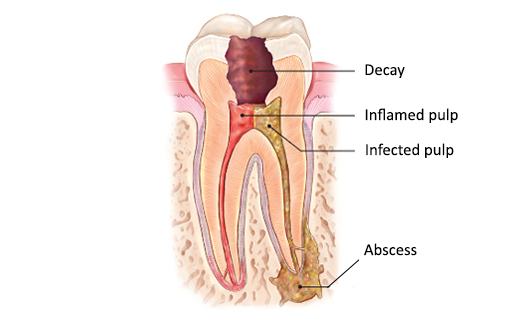


STEP BY STEP ENDODONTIC PROCEDURE
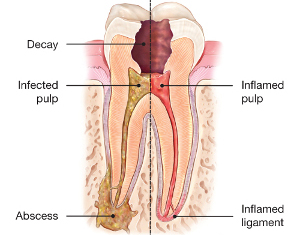
- Step 1.
The endodontist examines and takes a radiograph of the tooth using x-rays, then administers local anesthetic. After the tooth is numb, the endodontist places a small protective sheet called a “dental dam” over the area to isolate the tooth and keep it clean and free of saliva during the procedure.
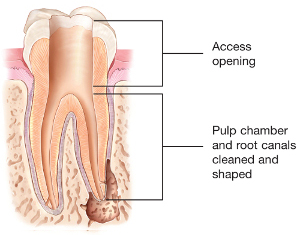
- Step 2.
The endodontist makes an opening in the crown of the tooth. Very small instruments are used to clean the pulp from the pulp chamber and root canals and to shape the space for filling.
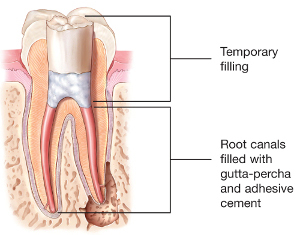
- Step 3.
After space is cleaned and shaped, the endodontist fills the root canals with a biocompatible material, usually a rubber-like material called gutta-percha. The gutta-percha is placed with an adhesive cement to ensure complete sealing of the root canals. In most cases, a temporary filling is placed to close the opening. The temporary filling will be removed by your dentist before the tooth is restored.
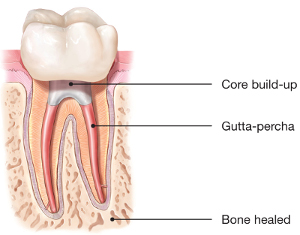
- Step 4.
After the final visit with your endodontist, you must return to your dentist to have a crown or other restoration placed on the tooth to protect and restore it to full function.
WHAT TO EXPECT AFTER TREATMENT
While most root canal procedures result in minimal to no discomfort, it is quite normal for some teeth to be a bit problematic after treatment. Most of the time, the pain is mild, but there are cases where the pain can be acute for a short period of time after the initial treatment. Usually these symptoms are normal, not serious and resolve quickly. This is why you have to be consistent with taking your medications as directed by your doctor. There are a number of possible causes of pain after the completion of a root canal. Even though the living pulp tissues are removed after your root canal, nerve endings remain in the ligaments that attach the tooth to the surrounding bone. These ligaments have nerve fibers associated with them that can feel pain. These fibers (not the pulp tissue or the tooth) are the source of post root canal pain.
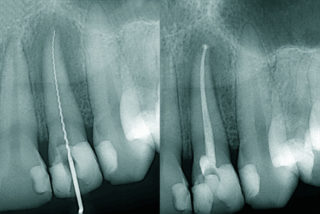
DIFFERENT CAUSES OF POST-OPERATIVE PAIN
PRIOR PAIN
If the tooth was painful prior to your procedure, there is a good chance that it may be more irritated and painful after the procedure. You can even get a slight to moderate amount of swelling around the tooth or the gum. The reason for this is that the tooth was further irritated due to the root canal procedure itself and enhanced by the already inflamed periapical tissues that surround the tooth. Additionally, inflammation may also be caused by the irritation of the physical instrumentation that is required during the endodontic procedure to clean the canals. Sometimes the root canal files can either push some debris past the end of the root or just injure the fine ligaments around the roots. The inflammation and swelling (if present) usually resolves by itself given enough time. Your doctor is aware of what post operative complications may occur on a case to case basis. If necessary, You will be prescribed specific medications that will help you during this phase.
HIGH BITE
Another source of post root canal discomfort is a high bite. A high bite occurs when your teeth are not coming together properly and hurts every time you bite down with nothing your mouth. Unfortunately, the inflammation that occurs around the tissues of the tooth after the root canal can be significant and can actually push the tooth up and out of the socket slightly into a different position. Subsequently, you will feel pain because you’re biting on this tooth first. This can be easily and quickly corrected by a bite adjustment. If chewing is uncomfortable or if you bite down with no food in your mouth and the treated tooth still hurts – the bite should be adjusted immediately. You will need to give us a call so we can get you right in. Teeth undergoing root canal should not be in a heavy occlusion or in other words, a heavy bite.
PERSISTENT INFECTION
Other possible causes of pain may be due to persistent infection. If a root canal is completed, but the infection is still present and persists without resolution, there are other procedures that may help resolve the problem. Other times, an infection may not be resolved, especially when it is related to a root fracture. In these cases the tooth usually has a poor to hopeless prognosis and may require extraction.

EDUCATIONAL VIDEOS
Root Canal Treatment
Need a root canal? Don’t be anxious. This informative video will walk you step-by-step through the procedure and explain how endodontists, the root canal specialists, can save your teeth.
Endodontic Retreatment
It’s possible that a tooth that has undergone a root canal may heal improperly and require an additional treatment. Watch this video to learn more about this endodontic procedure.
Endodontic Surgery
Learn about Apicoectomy, the surgical procedure endodontists perform, involving the ectomy of the apex, to treat an abscess or infection and save your tooth.
Cracked Teeth
Learn about the symptoms and types of cracked teeth and how endodontists help patients avoid tooth extraction.




© 2023 Endodontic Specialty Group, LLC. All rights reserved.


